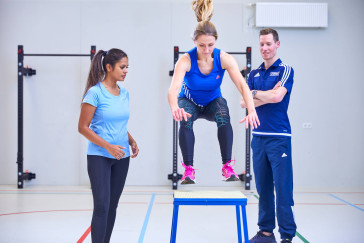With artificial intelligence (AI) systems entering our working and leisure environments with increasing adaptation and learning capabilities, new opportunities arise for developing hybrid (human-AI) intelligence (HI) systems, comprising new ways of collaboration. However, there is not yet a structured way of specifying design solutions of collaboration for hybrid intelligence (HI) systems and there is a lack of best practices shared across application domains. We address this gap by investigating the generalization of specific design solutions into design patterns that can be shared and applied in different contexts. We present a human-centered bottom-up approach for the specification of design solutions and their abstraction into team design patterns. We apply the proposed approach for 4 concrete HI use cases and show the successful extraction of team design patterns that are generalizable, providing re-usable design components across various domains. This work advances previous research on team design patterns and designing applications of HI systems.
MULTIFILE

Mapping Microplastics was a first exploratory workshop (part of the Entrepreneurship Program at HvA) with researchers and entrepreneurs to map how the public discourse on microplastics develops on Twitter.The preparation of this workshop followed a hybrid approach in three steps: preliminary mapping, joint interpretation and annotation, map redesign and feedback. The preliminary mapping was performed by designing a query to collect tweets around the topic of Microplastics. To perform the data collection and preliminary analysis we used TCAT (Twitter Capturing and Analysis Toolset), a tool developed by the Digital Methods Initiative at the University of Amsterdam. A set of four maps was designed to address different sub questions through different visual models: networks of hashtags and users, image grids organized by time and frequency, alluvial diagrams and lists of most interacted with tweets. These maps were used in a joint interpretative hybrid session: the visual material was printed and sent to each partner. With the facilitation of designers and researchers, entrepreneurs annotated the printed maps in parallel online sessions.
DOCUMENT
Nomination Best Research & Practice Project Award at the EAPRIL conference, Jyväskylä, Finland. Hybrid forms of learning environments in vocational education are central to the two projects of this application: a design-oriented, applied research project from the Centre for Expertise in Vocational Education (ecbo-project) and an educational innovation/practitioner-research project (hpboproject). A PhD-research project is closely related.
DOCUMENT

Veel mbo-opleidingen kiezen voor praktijkroutes, hybride leeromgevingen en gepersonaliseerde leerroutes. Dit levert dilemma’s op bij de afsluiting van de opleiding. Gebruikelijke examens passen vaak niet meer. Deze opleidingen willen informatie uit het onderwijs laten meewegen in de diplomabeslissing en een mix aan bewijzen gebruiken uit praktijk, werk en andere leeromgevingen.
Als gevolg van de energietransitie wordt het steeds moeilijker om energieaanbod en -vraag op elkaar af te stemmen en ontstaan problemen op het elektriciteitsnet. Energieopslag biedt een oplossing: duurzame energie wordt opgeslagen op momenten dat er aanbod en weinig energievraag is en beschikbaar gesteld wanneer er weinig aanbod en veel vraag is. Lokale opslag biedt een kans om lokale uitval van het elektriciteitsnet te voorkomen en geeft meerwaarde aan duurzame energie. Opslag in waterstof is uitermate geschikt voor zowel toepassingen op MW-schaal (windparken), voor seizoensopslag en voor toepassingen waar distributie relevant is. De wens van bedrijventerreinen om te verduurzamen biedt een kans om gericht aan oplossingen voor lokale energieopslag in waterstof en bijbehorende toepassingen te werken. In dit project werkt de HAN samen met MKB-bedrijven, Saxion, TU Delft, lokale overheden en een aantal overige partners aan het ontwikkelen en optimaliseren van een energieopslagsysteem gebaseerd op waterstof en bijbehorende waterstoftoepassingen op en voor bedrijventerrein IPKW in Arnhem. Beschikbare windenergie van in aanbouw zijnde turbines langs de Rijn bij IPKW vormen de aanleiding voor het ontwerpen, modelleren, construeren en testen van een (geschaald) energieopslagsysteem gebaseerd op de productie, en opslag van waterstof. Specifieke toepassingen op het industriepark worden geïnventariseerd, en waar mogelijk gerealiseerd en gemonitord, voor met name lokaal bedrijfstransport en elektriciteitslevering. Scenario’s voor ontwikkeling en toepassing van de technologie ontwikkeld en haalbaarheidsstudies uitgevoerd. Kennis en expertise worden ontwikkeld om het proces van optimale implementatie van waterstof voor energieopslag in een energieketen met specifieke toepassingen op een bedrijventerrein te ondersteunen. Met dit project bouwen wij voort op de vele eerdere waterstofprojecten die bij de HAN zijn uitgevoerd en maken we gebruik van ons recent gerealiseerde shared facility HAN Waterstoflab op IPKW.
In het beroepsonderwijs leren studenten op school en in de beroepspraktijk. Leeromgevingen op de grens van school en werk helpen studenten om beide contexten met elkaar te verbinden. Hoe kunnen we deze leeromgevingen typeren en hoe kunnen we verschillende types vormgeven?
